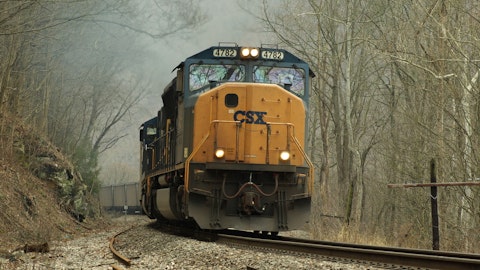Matthew Elkott: That’s good to know Rafael. And speaking of international, I think last month, Siemens announced the 1,200 freight locomotive order with Indian railways. Is that something you guys would have bid on and just generally, any update on the India opportunity for you guys will be helpful, there’s a significant infrastructure effort there, and I think they just raised their CAPEX for that for the next fiscal year to 10 trillion Rupees or $120 billion?
Rafael Santana: John and I have the opportunity to be in India end of last year. And I mean, we certainly see, I think growing momentum in terms of the opportunities there. As you know, we have long-term agreements. We are — we have, at this point, delivered over 500 units of that agreement. I think there is good opportunities here to further build on that momentum. I think there is demand for more, transit has a very significant footprint and I think one that we can take advantage. We’ve been, I think, earlier into the market from that perspective. When it comes down to evaluating order opportunities for the business, that’s something we do always. And if we see an opportunity to step into a market with a differentiated product we’ll certainly do that and that’s something that we’ll continue to evaluate for the business to certainly take from our customers in various parts of the world, a request that we look at some of those opportunities.
John Olin: And then the order Siemens, that was for electric locomotives that we are currently not in the market.
Matthew Elkott: Yes. And John, I’m sorry if I missed it. The sequential decrease in the total backlog this quarter and last quarter, did you say anything about that, I know it’s not significant, but it nonetheless has decreased?
John Olin: Yes, Matt. It’s just the — our technical term is lumpiness of backlogs. When we look at 2022, we had a very strong year in overall backlog. So they were both up — but if you look at it on a quarterly basis, there is a lot of volatility. So the first half — the first quarter in 2022, we’re up $0.5 billion, $600 million in the second quarter and then down in the third quarter, about $4 million to $5 million and down 500 in the fourth. So it’s just a nature of how the backlogs come in and go out and what we’re comparing to and lapping. So you’re always going to see a fair amount of volatility from quarter-to-quarter.
Rafael Santana: Matt, one of the things that I think it’s very important to keep in mind are the following. When orders that cover now three years ahead, you’re not going to see those repeat itself every year. And we’ve got quite a bit of those, which actually provide, I think, a lot of the visibility that I described to you guys. So I’d be careful on looking on I’m going to call separate quarters basis. What we have is, I’ll call, stronger coverage than probably we’ve had since 2019, to be very honest, as I look into the next 12 months and specific when it comes down to modernization, that goes out now to 25%. And for new units, I mean, as we have some long-term agreements, I mean some of those goes way out there, especially in the case of India.
Matthew Elkott: Yes. Makes sense. Thanks Rafael, thanks John, thanks Kristine.
Rafael Santana: Thank you.
Operator: The next question comes from Dylan Cumming with Morgan Stanley. Please go ahead.
Dillon Cumming: Great, good morning. Thanks for the questions. I just wanted to play devil’s advocate for a second on the kind of new local outlook. I think a lot of the factors that you mentioned in terms of elevated fleet age, right, desire to kind of increase fuel efficiency that have been present in the market for a while. So in terms of the visibility that you have to get to that kind of above 600-unit milestone you laid out, I guess, is my short kind of question is like what time — like why is this time different, are you having conversations with Class 1s that are giving you visibility to that number or what’s actually driving the confidence in reaching that milestone?
Rafael Santana: So I’ll go back to my early comments, I’m not going to speculate on how the recovery or volume I have looks like. What I can tell you is we’ve got great coverage done we had in the business especially if I go back like 2019, and that’s represented by backlog we have. I think the other point we wanted to make there is that we’re still at trough levels and if you connect out to the age of the fleet, if you connect that to the elements of how you continue to drive productivity, if you start thinking about obsolescence of components into that fleet together with the component of the ESG, I think you’ve got a lot of opportunity here to continue to build out on that momentum. That’s really the point that we want to make.
Dillon Cumming: Got you. Thanks Rafael. And if I can just ask a little more on the digital growth in the quarter. It was super strong. I know there was some M&A tailwind in there as well. But considering it was one of the last verticals that are going to recover post COVID, I know a lot of the Class 1s had pushed out investment in that area now seems to be really materializing in your own revenue profile. If you want to assume a barricades for Class 1 CAPEX and rail volumes in next year, just how durable could that digital growth be just considering that, that investment has been pushed out to the right for so long on the part of the Class 1s?





